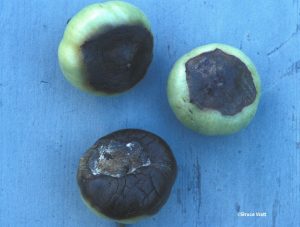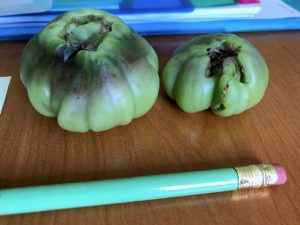Blossom End Rot
Pest Management Fact Sheet #5062
Authors: Dr. Alicyn Smart and Abigayl Novak
For information about UMaine Extension programs and resources, visit extension.umaine.edu.
Find more of our publications and books at extension.umaine.edu/publications/.
Abiotic Disorder: Deficiency of Calcium
Introduction
Blossom end rot is a physiological disorder relating to a calcium deficiency and is detrimental to both tomato growers and home gardeners. Fruits 1-3 weeks old are most susceptible to this disorder due to the increased requirement of calcium for rapid fruit growth. Calcium is a none mobile nutrient, meaning it does not move throughout the plant easily. If there is a limited amount of calcium in the soil, water or roots for the nutrient to be taken up and moved throughout the plant, the fruit will not have a sufficient amount of calcium to form healthy fruit. High levels of salt and use of ammonium nitrogen is also a contributing factor to increasing the occurrence of this disease.
Host Plants
- Tomatoes (Solanaceae); less common on peppers (Piperaceae), squash (Cucurbitaceae), and eggplant (Solanaceae
Symptoms and Signs
This disorder shows up as light-tan, water-soaked lesions on tomato fruit. Most lesions develop at the blossom end of the fruit and in rare cases, internal growth of lesions can appear. As Blossom end rot progresses, the lesions enlarge in a circular pattern and appear as a black leathery texture (Figure 1 and 2). If left too long the disease can lead to secondary black mold. Fruits with this disorder grow and ripen more rapidly than normal, especially if they are on the windward side of the farm or garden. This disorder does not spread from one plant to the next like a pathogenic disease might.
- Figure 1. Tomatoes with blossom end rot. Photo by Dr. Bruce Watt.
- Figure 2. Blossom end rot symptoms on tomatoes. Photo by Cathryn Kloetzli.
Management
- Get a soil test to ensure the proper level of calcium in the soil. This can be done at the University of Maine Soil Testing Laboratory.
- 2-4 months before planting apply lime with dolomitic or high-calcium limestone.
- Maintain a steady water supply and water flow in well-drained areas. Irrigation and mulching could be useful.
- Choose resistant varieties of tomato like Jet star, Bupee VF, Better boy, Early girl, Flora-Dade, Floramerica and Walter.
- No pesticides are recommended due to this being a nutrient problem rather than a pathological disease
- During the growing season apply foliar spray with anhydrous calcium chloride if you are experiencing a calcium deficiency with high levels of salt.
- Avoid products with high levels of potassium, sodium, magnesium, and ammonium. These nutrients compete with calcium for uptake.
References
Jensen, Sandra Lorraine. “Blossom End Rot.” February 2018. Cornell University. http://plantclinic.cornell.edu/factsheets/blossomendrot.pdf. 24 June 2019.
Jones, Jeffrey B., et al. Compendium of Tomato Diseases and Pests. The American Phytopathological Society, 2014.
Joy, Ann and Brian Hudelson. “Blossom end rot.” 1 April 2005. Wisconsin Horticulture Division of Extension. https://hort.extension.wisc.edu/articles/blossom-end-rot/. 24 June 2019.
Whitlock, Linda, Bridget Behe and Rebecca Finneran. “Blossom-end rot.” 1 September 2016. Michigan State University. https://www.canr.msu.edu/resources/blossom_end_rot_tip_sheet. 24 June 2019.
WHEN USING PESTICIDES, ALWAYS FOLLOW LABEL DIRECTIONS!
Alicyn Smart, DPM
Plant Pathologist and Director of the Plant Disease Diagnostic Laboratory
University of Maine Cooperative Extension
Information in this publication is provided purely for educational purposes. No responsibility is assumed for any problems associated with the use of products or services mentioned. No endorsement of products or companies is intended, nor is criticism of unnamed products or companies implied.
© 2019
Call 800.287.0274 (in Maine), or 207.581.3188, for information on publications and program offerings from University of Maine Cooperative Extension, or visit extension.umaine.edu.
The University of Maine is an EEO/AA employer, and does not discriminate on the grounds of race, color, religion, sex, sexual orientation, transgender status, gender expression, national origin, citizenship status, age, disability, genetic information or veteran’s status in employment, education, and all other programs and activities. The following person has been designated to handle inquiries regarding non-discrimination policies: Director of Equal Opportunity, 101 North Stevens Hall, University of Maine, Orono, ME 04469-5754, 207.581.1226, TTY 711 (Maine Relay System).



